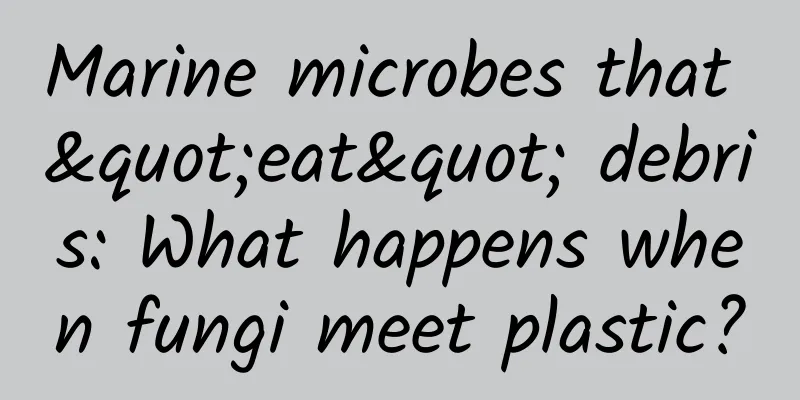Marine microbes that "eat" debris: What happens when fungi meet plastic?

|
Produced by | Science Popularization China Author: Liu Rui, Fei Fan (Institute of Oceanology, Chinese Academy of Sciences) Producer | China Science Expo Editor | Tian Wei If you look around you, is it possible to find something that does not contain plastic? In our daily lives, we cannot live without plastics - from shopping bags and plastic bottles to cars, home decoration, and the production of mobile phones and computers also requires the participation of plastics. Large-scale plastic production has brought convenience to people, but it has also brought problems to nature - ordinary plastics take decades or even hundreds of years to degrade. Judging from the production rate and degradation rate, the earth will soon become a huge plastic garbage dump. Various types of plastics | Image source: Veer Gallery Therefore, how to degrade plastic faster and better has become an urgent problem for scientists to solve. In 2021, scientists first discovered marine microbial flora that can effectively degrade plastic waste; now, they have discovered and cultivated an "upgraded version" of marine microorganisms that can not only effectively degrade various types of plastics, but also degrade faster, degrading some plastics into fragments within two weeks. What kind of magical microorganisms are these? How do they chew and digest such strong plastic? With them, does it mean that humans can use plastics without worry? Members of Sun Chaomin's team are studying marine microorganisms that "eat" debris. Image source: Institute of Oceanology, Chinese Academy of Sciences 1 Plastic pollution has become an epidemic Knowing yourself and your enemy, you can fight a hundred battles without defeat. Before we understand how to degrade plastics, we need to know what plastics are. Plastics are a type of artificially synthesized high-molecular polymers with excellent performance. In addition to the renewable materials and mineral salts that have gradually emerged in recent years, the synthetic raw materials are mainly petroleum, that is, petroleum-based plastics. Every year, the world can produce about 350-400 million tons of synthetic plastics, and the main economic varieties include polypropylene, polyethylene, polystyrene, polyvinyl chloride and polyurethane. Like many inventions, plastic itself is not a "bad substance", but due to the lack of disposal measures corresponding to the huge output, plastic waste spreads uncontrollably in the environment and has become a global pollution problem. Some plastic products from land have even been carried into the ocean, causing serious damage to the marine ecosystem. Statistics provided by the United Nations Environment Programme show that the world's plastic production has soared from 2 million tons in 1950 to 348 million tons in 2017, and production capacity is expected to double by 2040. About 11 million tons of plastic waste flows into the ocean every year. By 2040, this number may triple. Plastic production and pollution are causing a "triple crisis" in climate change, nature loss and pollution on the planet on which human beings depend for survival and triggering a disaster. Massive plastic production and waste are causing a "triple crisis" in climate change, nature loss and pollution. Land where plastic waste accumulates | Image source: pixabay In order to deal with and solve this pollution problem that has plagued human society for many years, scientists have set their sights on a wide variety of microorganisms. These "inconspicuous" biological groups are found in a variety of ecological environments on the earth and have strong adaptability and diverse functional characteristics. Therefore, in places and environments where plastic waste exists for a long time, is it possible that there are microorganisms that can utilize and "eat" plastic? Based on this conjecture, the researchers collected hundreds of plastic waste samples of various materials from the intertidal zones of beaches where human activities are frequent. Through broad-spectrum screening, they finally successfully isolated a marine fungus that can effectively colonize and degrade polyethylene plastic. 2 What happens when fungi meet plastic? When the fungus is incubated with a plastic film, the hyphae of the fungus will adhere tightly to the plastic surface. This actually solves a major problem in plastic degradation - the plastic surface is highly hydrophobic, making it difficult for general microorganisms to adsorb. The hydrophobicity here can be simply understood as the ability of a material surface to be wetted by water. If we immerse a piece of paper and a piece of plastic in water at the same time, the paper is easily wetted by water, and a large number of water molecules are retained on the surface, but the plastic is almost impervious to water. Because of this, it is difficult for water to stay on the surface of plastic, so it is difficult for ordinary microorganisms to stay here, and they will move away as soon as the waves wash over them. What makes this fungus different is that it has the ability to secrete hydrophobic proteins and form an amphiphilic film at the hydrophobic/hydrophilic interface, increasing the contact area with the plastic, outperforming other microorganisms in the first step! Biodegradation process of polymers | Image source: Magnin A, Pollet E, Phalip V, et al. Evaluation of biological degradation of polyurethanes [J]. Biotechnology Advances, 2020, 39 After adsorption, the fungi's developed hyphae structure can secrete a variety of extracellular enzymes and act on plastics. Just as salivary amylase in saliva can hydrolyze long-chain starch in rice, making it smaller and easier for the human body to absorb, microorganisms can also synthesize their own enzyme system to gradually degrade macromolecules outside the microorganism, interrupt their long-chain structure, make the molecules of these substances smaller, and then start a "good meal". Plastics are also long-chain macromolecules with complex structures, and this fungus happens to be able to secrete enzymes that break down these macromolecules, achieving an important step in plastic degradation: degradation and depolymerization. In addition to the characteristics of the fungi themselves, living in close contact with piles of plastic has also caused them to evolve, or be screened out, the ability to decompose and utilize plastics, thus gradually evolving into some groups that can effectively degrade plastics. For many microorganisms, if they are fed with bread and rice, they will live well, but if they do not have such a good living environment, such as microorganisms living around plastic waste for a long time, in order to survive, they will slowly "evolve" and "eat" plastic by secreting enzymes to obtain additional energy sources. This also reflects the characteristics of mutual influence, interaction and mutual adaptation between microorganisms and the environment. After incubation with fungi, obvious wrinkles and cracks appeared on the surface of polyethylene plastic. Scanning electron microscopy observations showed dense holes on the microscopic surface of the plastic, indicating that the hyphae attached to the plastic had penetrated the plastic surface and exerted a degradation effect. Fungal colonization and degradation of polyethylene plastics | Image source: Institute of Oceanology, Chinese Academy of Sciences Scanning electron microscope observation of fungi degrading polyethylene plastics | Image source: Institute of Oceanology, Chinese Academy of Sciences 3 The fungus exhibits a broad spectrum of degradation capabilities Subsequent experiments revealed that the ability of this fungus is not limited to this. It seems to be able to degrade more plastic substrates, such as polyurethane, polyvinyl chloride, polystyrene, polypropylene, etc. Among them, polyurethane plastics are widely used in industries such as electrical appliance manufacturing, automobiles, construction, and clothing. For example, polyurethane is used in sound-absorbing materials and thermal insulation materials. Its market share is second only to the four polyolefin plastics. Since its introduction in the 1930s, a lot of polyurethane waste has accumulated in the environment. This fungus can degrade polyurethane products at a speed visible to the naked eye. After 2 weeks of fungal treatment, cracks appeared on the surface of the polyurethane membrane. After the treatment time was extended to 5 weeks, the membrane showed obvious fragmentation and the degradation effect was good. Polyurethane plastic film is degraded by marine fungi within 4 weeks. Image source: Institute of Oceanology, Chinese Academy of Sciences Since it can effectively degrade ordinary plastics, if the object to be treated is degradable plastics, can't we improve the degradation efficiency and shorten the degradation cycle on the original basis? The answer is yes. After only one week of incubation, obvious cracks appeared on the surface of the biodegradable plastic and the plastic turned yellow, which was a sign of oxidation and erosion. When the time reached two weeks, the area of erosion on the plastic surface increased significantly, and even larger holes appeared. After three weeks, there were very few plastic residues. If the biodegradable plastic was left for a while longer, it would be completely metabolized and utilized by the fungi. Degradable plastic bags containing PBAT+PLA+St were degraded by marine fungi within 4 weeks. Image source: Institute of Oceanology, Chinese Academy of Sciences 4 Degradable plastics are recommended Compared with the hundreds of years of degradation of traditional plastic products in the natural environment, biodegradable plastics shorten the degradation process to a few months, which is a great progress in the history of synthetic plastics. It is recommended to use biodegradable plastics here and look for the "biodegradable plastics" logo. The logo is a pattern composed of a circular circle with an arrow, double "j" (the first letter of the pinyin for degradation), material abbreviations (such as PBAT, PLA, etc.), national standards and product names. Example of "degradable plastic" labeling | Image source: National Standard GB/T 41010-2021 The corresponding national standard is GB/T 41010-2021 and will be implemented on June 1, 2022. Products certified in accordance with this national standard have passed the corresponding degradation rate, heavy metal content and toxicity tests of degradation products, and are highly environmentally safe. It is worth noting that the biodegradable plastics used in daily life cannot be completely degraded by simple wind and sun exposure, and the degradation rate is very low. They will still pollute the environment. If they flow into the ocean and are swallowed by creatures such as turtles, they are very likely to block the digestive tract and cause death. By using biodegradable plastics, we can achieve a convenient life while protecting the environment. Of course, we should also develop the awareness of using plastic products in moderation - such as carrying shopping bags when going out and reducing the use of disposable items. As long as everyone can maintain green good habits in their lives, I believe our environment will be greatly different. Special Tips 1. Go to the "Featured Column" at the bottom of the menu of the "Fanpu" WeChat public account to read a series of popular science articles on different topics. 2. Fanpu provides a function to search articles by month. Follow the official account and reply with the four-digit year + month, such as "1903", to get the article index for March 2019, and so on. Copyright statement: Personal forwarding is welcome. Any form of media or organization is not allowed to reprint or excerpt without authorization. For reprint authorization, please contact the backstage of the "Fanpu" WeChat public account. |
<<: What genes of ancient humans are flowing in us?
>>: Listen to Chen Dong’s growth story: It feels so good to have a dream come true!
Recommend
Design idea: open source offline map application on Android platform
[[134364]] In order to realize the full potential...
"The sea is wide and the fish can leap for it" is just a beautiful imagination of submarine underwater navigation
Produced by: Science Popularization China Produce...
What is the effect of micro-loan advertising on Momo?
We can see a lot of micro-loan advertisements on ...
Does eating leftover rice and vegetables cause cancer? Can we still eat them? One article explains
Author | Xue Qingxin, registered nutritionist, re...
Dalian will conduct nucleic acid testing on 190,000 people, and the sudden local confirmed cases have attracted attention!
Chinanews.com, Dalian, July 23 (Reporter Yang Yi)...
This is how you can attract new users and promote activation of your APP!
In the era of mobile Internet, daily active users...
Three generations of the F-15 family gathered at Nellis Air Force Base to conduct F-15EX combat test missions
From October 18 to 25, 2021, the F-15EX Eagle II ...
"Healthy through eating" series | Where are nitrites hidden? Eating this way can reduce your intake
In recent years, the media has repeatedly reporte...
Reaching new heights: James Webb Space Telescope discovers record-breaking ancient galaxy
Recently, astronomers announced the discovery of ...
14 PPTs let you master all promotion channels and their characteristics!
Mobile application product promotion services: AS...
Scissor doors are not uncommon. McLaren's mini electric sports car has built-in nursery rhymes
Foreign media reports: McLaren, a famous British ...
In 2020, mobile phone manufacturers will not be able to wait for the 5G trend
In the mobile phone industry, the following judgm...
The clearest and most comprehensive method for writing operation and promotion plans!
Operations are basically a process of constantly ...
Will artificial intelligence replace humans? Don't worry, you're overthinking it
TechCrunch, a US technology website, wrote an arti...
The answers to the Super Code Challenge have been revealed! Which questions are you stuck on?
In this Super Code Challenge, we have set up four...









